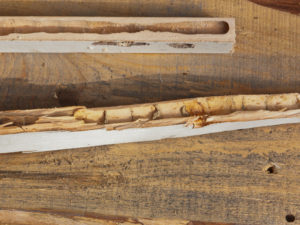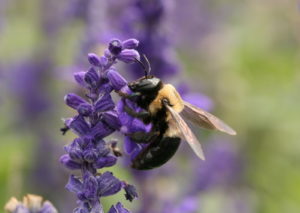By Karen Bussolini
This article was first posted on January 7, 2020, on the Karen Bussolini Garden Arts – Nurturing Gardens and Gardeners blog and is reprinted with the permission of the author.
Bees are smart. They recognize high-quality food and habitat. The buzz has gone out that my house is a happening place for carpenter bees.
Clues that it’s carpenter bee nesting season appear every spring.
- A faint hubbub outside my upstairs windows, like conversation verging on an argument.
- Looking out the window, I find myself face-to-face with what looks like a gigantic shiny black bumblebee hovering outside the screen.
- When I go outdoors I get divebombed – too close for comfort.
- Fine sawdust particles drift like gently falling snow past the windows.
- Followed by fans of waxy bee excrement splattered on siding and stuck in window screens. Yuk.
- Looking up, I see fresh perfectly round ½” holes in trim under the eaves.
- After a few weeks, woodpeckers start hammering away. It’s not noisy, like mating season drumming on gutters. They just quietly demolish my house to slurp up juicy bee larvae inside tunnels.

Carpenter Bee’s damage to my house.
Judging by the bee traps I see hanging from so many eaves, people are going nuts trying to get rid of them.
But why jump straight from establishing pollinator pathways to going on the warpath against the bees?
Why plant gardens to attract bees and then kill them as soon as they make themselves at home?
It seems like every time I do an Internet search to understand the life cycle of a particular insect, what comes up first is recommended insecticides and ads for pest control services.
I’ve noticed that DIY bee trap construction instructions are all very “can do,” but tend to end in a passive, distanced voice – “accumulations of dead bees are disposed of by unscrewing and rinsing out the bottle.” There’s a disconnect between good intentions and deadly results.
Dealing with Carpenter Bees
Let’s look at the habits and life cycle of carpenter bees for clues to peaceful coexistence, so we can figure out how to deal with them come spring.
Large carpenter bees (Xylocopa virginica is our northeastern species) are solitary bees that produce one generation per year. Each female lays eggs in its individual brood tunnel, although often in close proximity to others.
Unlike colony-forming honeybees, they do not make hives or honey and aren’t big on stinging.
Females can sting if provoked by rough handling. Territorial males are loud and intimidating when they buzz you, but they don’t even have stingers – it’s all for show.
(Please don’t whack them with a tennis racquet as one stupid blog I read advised).
When unnerved by one particularly aggressive dive-bomber, I found that spraying a jet of water from the hose convinced it to go away long enough for me to finish what I was doing.
Young adults emerge in spring and forage energetically. Our largest and farthest-flying native bee species, large carpenter bees are important pollinators of fruit trees, redbuds, catalpas, and other early blooming plants.
They need to quickly build energy to mate, create, provision a nest (brood tunnels), and lay eggs. Male carpenter bees die after mating, females after laying eggs, in late spring or early summer.
A fertilized female will excavate, re-use, or extend a tunnel to prepare five or six brood cells.
She provisions each individual cell with a ball of pollen and regurgitated nectar (“bee bread”), onto which she lays one egg. She then seals each cell with regurgitated wood pulp.
Carpenter bees prefer softwoods like pine, cedar, cypress, and redwood, bare (unpainted, bark-free) and weathered wood, at least 2″ thick. They excavate but, unlike carpenter ants and termites, do not eat wood.
I was relieved to learn that they bore in only about 1″ then make a 90º turn and tunnel parallel to the edge of the board, with the grain. This protects the brood from moisture, direct sun, pecking birds (except clever woodpeckers), and probing or insecticide-spraying homeowners.
Eggs hatch and go through several life stages. Grub-like larvae grow fast, nourished by bee bread, then metamorphose into pupae – almost adults, but helpless and inactive.
Later in summer pupae metamorphose into adults, break out of the brood cells and get back to the important work of pollinating. They’re too big to crawl inside tubular flowers but go for open-faced flowers and crops (tomatoes and eggplants) that require buzz pollination.
The Right Time for Action
After adult bees leave the nest is the time to make repairs without killing these gentle, beneficial pests. You can tell they’re gone when entrances are no longer sealed.
Carpenter bees overwinter in those tunnels and extend or drill new ones in spring, so do what needs to be done while they’re out frolicking in the flowers.
The first line of defense – fill the holes (some recommend stuffing them with steel wool before applying wood filler) and paint, rather than stain your trim. A thick glossy coat of paint is wonderfully discouraging.
My house was stained (with wood stain and bee poop), full of holes, and had some rotten trim.
As much as I’d rather avoid plastics, I took my builder’s suggestion to replace damaged trim with PVC lumber and apply thin strips of that material over vulnerable areas. Painted, it looks like wood and – the plus and minus of plastics – it will last forever.

Xylocopa_Latreille carpenter-bee one of the largest native bees in the United States
Bees should find the PVC an unappealing mouthful.
If further discouragement is needed, I read that bees have a natural aversion to citrus and almond oil sprays – worth a try. I’ll disregard the suggestion to play loud music for two or three days (they’re apparently sensitive to noise and/or vibrations), which would drive me nuts on Day 1.
The photo above shows two pieces of my thoroughly tunneled trim, with remnants of wood pulp cell divisions.
Looking around for a simple background for the photo, I grabbed a thick rough-cut pine slab, scrap from a local sawmill, in the “split for kindling” pile. Then I noticed perfectly round ½” holes in that board too.
I don’t want to kill or drive carpenter bees away, I just don’t want them messing with my house.
Those holes were a good clue. I hung that pine slab undercover in a woodshed, where bees are welcome.
About the Author
Karen Bussolini has been a gardener all her life. She trained as a painter and was an architectural photographer before specializing in garden photography, writing, speaking, and eco-friendly garden coaching/design. She is a NOFA (Northeast Organic Farmers Association) Accredited Organic Land Care Professional. Her garden has been featured in many publications, including Anne Raver’s feature, “A Hillside of Feisty Beauties” in The New York Times.



